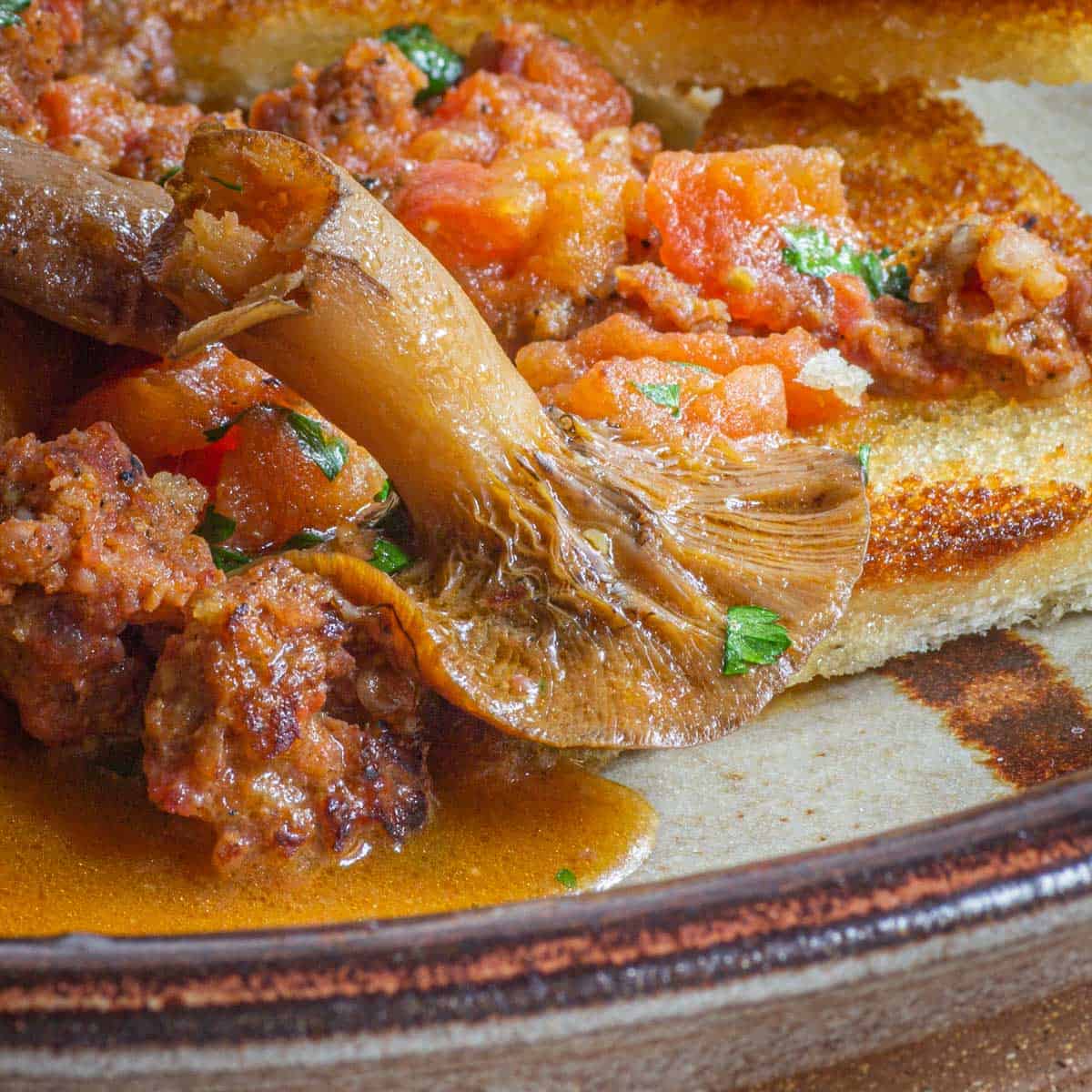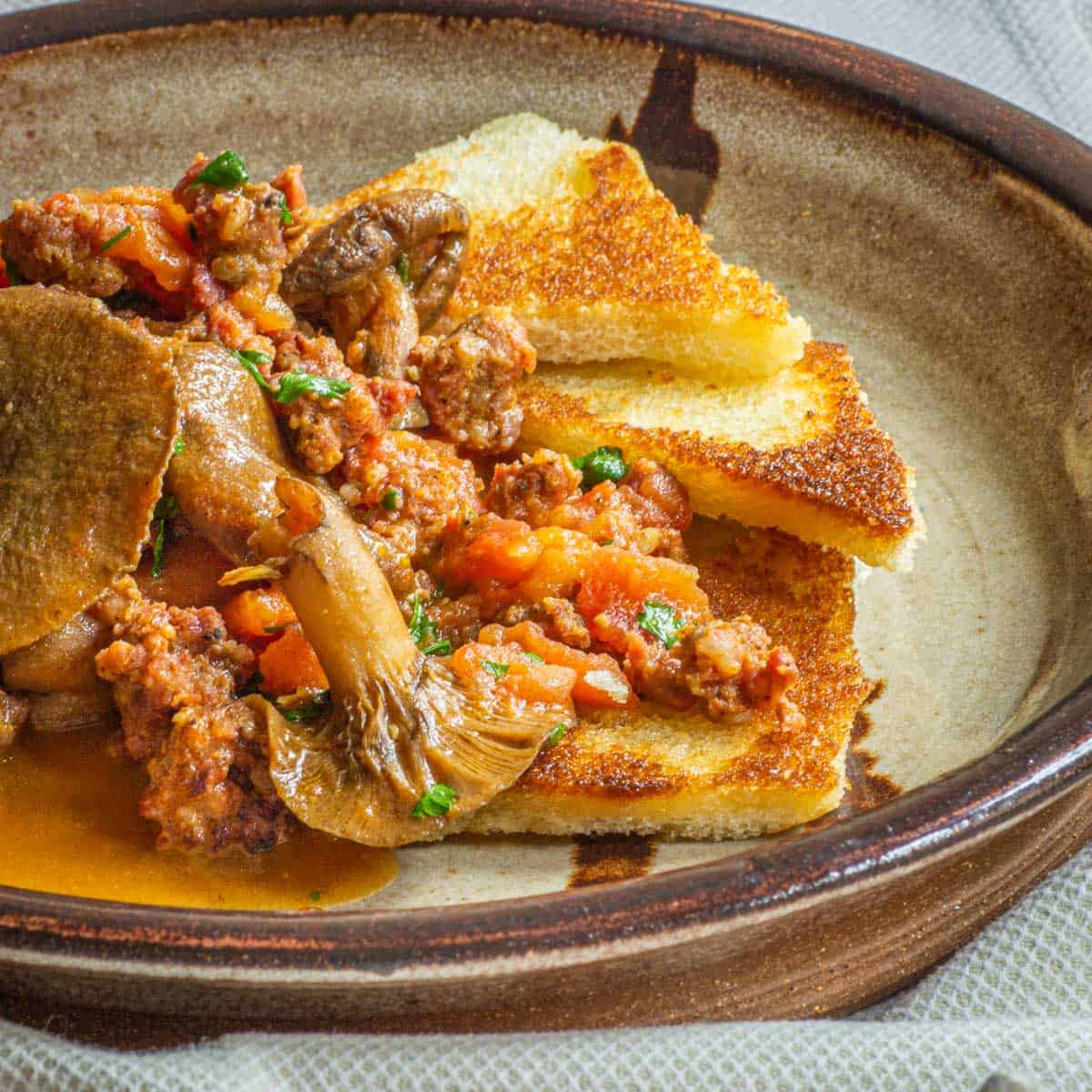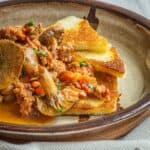Catalan Saffron Milk Caps, or milk cap mushrooms cooked with tomato and sausage and served with toast is one of my favorite saffron milk cap recipes.
I got the idea for it after reading a passage in a great book "Mushrooms and Russia in History", and it's authored by a very interesting and knowledgeable couple: Valentina Pavlovna Wasson, and Gordon Wasson, who also wrote about the SOMA, but that's another story. See and download your own copy of the book for free here.
In the book, Valentina waxes about the fascination of mushrooms by different cultures, and discusses specific favorites of Europeans from different regions. In the excerpt, Valentina is talking about saffron milkcaps, which the Spanish call either "rovellons" or "nizcalos". (Catalonia is a region in Eastern Spain)
"The Catalan prizes this mushroom highest of
all: he honors it above the cepe de Bordeaux. He puts his mess of rovellons into
a frying pan of very hot oil, and on top of the mushrooms he adds tomatoes
and garlic and parsley and sausage made from pork, and after cooking the whole
for ten minutes or less over a slow fire, he sits down to a dish that he considers
fit for the gods."
After reading the description I had to make a recipe. It's simple, delicious, and just screaming to be put on toast or pasta.
Other Milkcap Mushrooms to Use
Saffron milkcaps aren't the only mushroom you can use here. Any milkcap that you like to eat will work fine, and other mushrooms will work well too. Here's a few examples.
Serving
I like this as an appetizer, but it can also be served as a main dish. If you want to serve it as a main course, it can be a meal with a big green salad or sauteed vegetables on the side.

Catalan Saffron Milkcaps
Equipment
- 1 10 inch saute pan
Ingredients
- 8 oz fresh saffron milkcaps sliced if large, left whole if small
- ½ cup chopped peeled tomatoes
- 4 oz bulk chorizo sausage
- 2 tablespoons chopped flat leaf parsley
- 1 teaspoon chopped fresh garlic
- Kosher salt and pepper to taste
- 2 tablespoon extra virgin olive oil for garnishing preferably a peppery Spanish variety (optional)
- High quality bread crust removed and toasted
Instructions
- In a large saute pan, render the fat from the chorizo and brown it lightly. With a slotted spoon, remove the chorizo, leaving the fat in the pan.
- Reserve the chorizo until needed.
- Heat the remaining fat and add the saffron milkcaps. Cook the saffron milkcaps on medium-high heat until lightly browned and caramelized, about 5 minutes. Season the mushrooms lightly with salt.
- Add the garlic, stir and cook for 1 minute. Add the tomatoes, reserved chorizo and parsley and cook for 5 minutes more. Double check the seasoning for salt and pepper, then serve immediately on toast garnished with a drizzle of the olive oil.



Dkbax
I’m from Valencia which is the adjecent region to Catalunya and we basically have the same culture of eating rovellons. By far the most common preparation I’ve seen for them both in Valencia and Barcelona is “a la plancha”, which is dry frying in a pan with a little oil, with garlic, parsley and sometimes lemon juice. It works very well for them and they are often made to retain that pleasant grainy texture they have. I haven’t ever seen this recipe before but It could still be authentic of course!
Alan Bergo
I wouldn't have given this the name "Catalan" had I not seen it in a book described as a Catalan dish. Thanks for the reference on the a la plancha preparation, I'll be trying it on Lactarius thyinos later this week.
Eddie Wu
A friend of mine gave a bag of the the milk cap mushrooms which he picked from pine plantation in South Australia.. I will try to cook them with your recipe. I am very much interested in the book Mushrooms and Russia History. Could you send me a copy ?
Alan Bergo
I updated the post with a link to the download.
Peter Paterson's Work Imac
Foraged some of these (at least I hope that are1) today in the Adelaide hills. Can't wait to try your recipe also. Would really love a copy of your PDF too if possible please.
Lucky
Hey Alan, thanks for the great milk cap recipe. We have just found some near Melbourne in Australia, they have been introduced here with pine plantations. I would love the book Mushrooms and Russia In History if you have time to send, cooking up the milk caps now!
Garry McCreath
Hi,
great website, looking forward to trying some of your recipes, albeit adapted to a vegetarian version. I found you by searching for Saffron Milkcap recipes as I've just found my first batch. Very pleased : )
Could you send me a copy of the mushrooms and Russia pdf please? I've visited Poland a few times and enjoyed the mushroom culture there, I'm interested in how it looks further East.
Many thanks
Alan Bergo
Just sent it, thanks for stopping by. Most recipes not based around meat here will be easily adapted for vegetarians.
Adam Haack
Dude! This recipe looks incredible and that book sounds fascinating. I picked my first batch of Saffron's last week and can't wait to start trying them with different recipes. If you could shoot me through that PDF I'd be eternally grateful.
Peas
Alan Bergo
Sent. THX.
Steven Joubert Thorold
1stly: Brilliant recipe! I have been collecting and preparing saffron milkcaps (or pine rings - the common name in South Africa for Lactarius Deliciosus) for a few years now....and although I LOVE our family recipe ( which indulges in our Asia-Afro-Europian heritage) this recipe is DELICIOUS!
2ndly: Thank you SO much for sharing!
...and be 3:
I am generally not a fan of any tomato-based recipe , but this really does work!
Note:
We used less garlic (and freshly chopped - not pre-chopped!)
We served this on toasted rye- bread...
Alan Bergo
Thats great, thanks Steven. This was a fun recipe to put together, there are not many people who can say they have prepared a Traditional recipe for Spain's favorite mushroom.
Vicky
YAY! rovellons! delish.
Eileen Connor
Hi Alan,
I just found your blog and liked your facebook page (Forager Chef). Please send me the PDF book, “Mushrooms and Russia In History”, if you would.
I just found your site after trying to ID some mushrooms. I think I have found slippery jacks and another mushroom which I thought was a puffball, but when I sliced it open it looked more like a bolete-with stem. I would like to send you a few pictures-maybe on the Forager/Chef FB page?
Glad to know you are there. I cooked in local restaurants for about 15 years and am now practicing Chinese Medicine and painting. I am a forager too-glad to meet you!